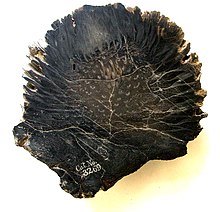Bennettitales
| Bennettitales Temporal range: Triassic to Oligocene |
|
|---|---|
 |
|
| A Cycadeoid, showing an "inflorescence" in the top-right | |
| Scientific classification | |
| Kingdom: | Plantae |
| (unranked): | Spermatophyta |
| Division: | Cycadophyta |
| Order: | Bennettitales † |
| Families | |
Bennettitales (the cycadeoids) is an extinct order of seed plants that first appeared in the Triassic period and became extinct in most areas toward the end of the Cretaceous (i.e. they existed around 252 to 66 million years ago), although some Bennettitales appear to have survived into Oligocene times in Tasmania and eastern Australia. Some were characterized by thick trunks and pinnately compound leaves that bore a superficial resemblance to those of cycads, differing primarily in stomatal arrangement.
The taxon comprises two groups, the Cycadeoidaceae, represented by Cycadeoidea and Monanthesia which had stout trunks and bisporangiate strobili (cones serving as their reproductive structures), and the Williamsoniaceae including Williamsonia, Williamsoniella, Wielandella and Ischnophyton which had slender, branching trunks and either bisporangiate or monosporangiate strobili. Bennettitales have been placed among the anthophytes and for some time were considered to be close relatives of the flowering plants on account of their flower-like reproductive structures (a whorl of microsporangiate structures that surround an inner receptacle). However, more detailed morphological studies have shown the hypothetical anthophytes clade to be polyphyletic, with the Bennettitales more closely related to the cycads, ginkgo and conifers than to the angiosperms. Molecular fossil evidence, however, indicates the possibility that Bennettitales and Angiosperms (along with Gigantopteridales) form a clade, based on the presence of oleanane in fossils of these groups.
...
Wikipedia
